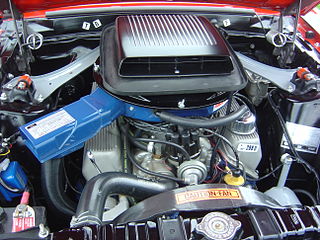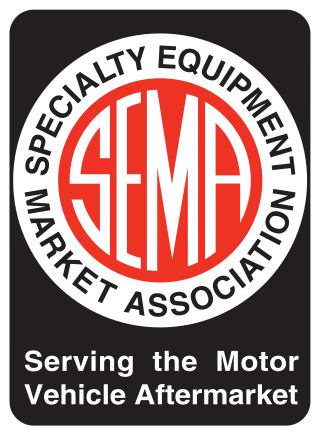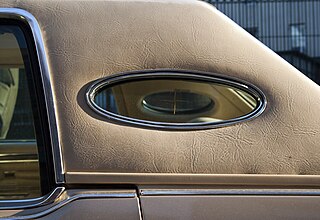Related Research Articles

Muscle car is a description according to the online Merriam-Webster Dictionary in 2022 that came to use in 1966 for "a group of American-made two-door sports coupes with powerful engines designed for high-performance driving." The online Britannica Dictionary described these in 2022 as "an American-made two-door sports car with a powerful engine."

The AMC Javelin is an American front-engine, rear-wheel-drive, two-door hardtop automobile manufactured by American Motors Corporation (AMC) across two generations, 1968 through 1970 and 1971 through 1974 model years. The car was positioned and marketed in the pony car market segment.

The Dodge Challenger is the name of three different generations of automobiles produced by American automobile manufacturer Dodge. However, the first use of the Challenger name by Dodge was in 1959 for marketing a "value version" of the full-sized Coronet Silver Challenger.

A shaker scoop is an automobile term for an air intake for combustion air that is mounted directly on top of the engine's air cleaner and protrudes through a hole in the hood. Since it is fastened directly to the engine, it moves with the engine's movement and vibration on its mountings, thus the 'shaker' name.

Pony car is an American car classification for affordable, compact, highly styled coupés or convertibles with a "sporty" or performance-oriented image. Common characteristics include rear-wheel drive, a long hood, a short decklid, a wide range of options to individualize each car and use of mass-produced parts shared with other models. The popularity of pony cars is largely due to the launch of the Ford Mustang in 1964.

The Plymouth Barracuda is a two-door pony car that was manufactured by Chrysler Corporation from 1964 through 1974 model years.

Specialty Equipment Market Association (SEMA) of the automobile aftermarket was formed in 1963 by Paul Schiefer, Roy Richter, Ed Iskenderian, Els Lohn, Willie Garner, Bob Hedman, Robert E. Wyman, John Bartlett, Phil Weiand Jr, Al Segal, Dean Moon, and Vic Edelbrock Jr. Now it consists of 6,383 companies worldwide, bringing together aftermarket manufacturers, original equipment manufacturers (OEM), media, car dealers, specialty equipment distributors, installers, retailers, and restoration specialists.

The Mustang Boss 302 is a high-performance 302 cu in (4.9 L) H.O. V8-powered variant of the Ford Mustang originally produced by Ford in 1969 and 1970. Developed to meet homologation requirements to compete in Trans Am racing, it was Ford's response to the success of the Chevrolet Camaro Z/28 in the 5 L (305.1 cu in) and under SCCA series since 1967. While substantial modifications were required to the stock Boss 302 to be competitive on the track, many thousands were sold to the public in a street-legal form that included a refined high-performance motor and upgrades to the suspension and brakes over base Mustangs.
Grand American was a NASCAR sanctioned series of pony car stock cars. The series ran from 1968 until 1972. The series was called "Grand Touring" from 1968 to 1969.

An opera window is a small fixed window usually behind the rear side window of an automobile. They are typically mounted in the C-pillar of some cars. The design feature was popular during the 1970s and early 1980s and adopted by domestic U.S. manufacturers, most often with a vinyl roof.
Hurst Performance, Inc. was an American manufacturer and marketer of automobile performance parts, most notably for muscle cars.

The second-generation Chevrolet Camaro is an American pony car that was produced by Chevrolet from 1970 through the 1981 model years. It was introduced in the spring of 1970. Build information for model 123-12487 was released to the assembly plants in February of that same year. It was longer, lower, and wider than the first generation Camaro. A convertible, which was available for the first generation, was unavailable for the second. GM engineers have said the second generation is much more of "A Driver's Car" than its predecessor. The high-performance Z/28 option remained available through 1975, redesignated as the Z28 in 1972.

Coke bottle styling is an automotive body design with a narrow center surrounded by flaring fenders. This design element bears a general resemblance to a Coca-Cola classic glass contour bottle design. Industrial designer Raymond Loewy introduced it on the radical 1962 Studebaker Avanti gran turismo.
American Muscle Car is a weekly television show on Speed, produced by Restoration Productions LLC., about muscle cars. Original release was in 2003. Each episode provides a timeline of each vehicle's history beginning with its first year of production to its most recent year of production. The show was initially designed to showcase traditional muscle cars such as the Chevrolet Camaro, Ford Mustang, and Dodge Charger. It eventually added other performance vehicles such as the Shelby Cobra and the, and even began to focus on specific eras such as the (disambiguation)|. In 2006 season, the show's focus was expanded to include designers and engineers of muscle car era.
The 1969 Trans-American Championship was the fourth running of the Sports Car Club of America's Trans-Am Series. The championship was open to SCCA Sedan category cars competing in Over 2 liter and Under 2 liter classes. 1969 marked the end of the use of co-drivers in the Trans-Am Championship, as most of the races were between 2.5 and 3 hours. The Over 2 liter and Under 2 liter Manufacturers' titles were won by Chevrolet and Porsche respectively.
This is a list of automobiles produced for the general public in the North American market. They are listed in chronological order from when each model began its model year. If a model did not have continuous production, it is listed again on the model year production resumed. Concept cars and submodels are not listed unless they are themselves notable.
The Max Wedge, formally the Maximum Performance Wedge, was an engine option produced by the Chrysler Corporation from 1962 to 1964, that was available exclusively in B Platform (intermediate) Dodges and Plymouths. The Max Wedge motor used the Chrysler RB Block, and was produced in 413 and 426 cubic-inch iterations. The 1962 Max Wedge Dodges and Plymouths, which offered a high-performance big-block engine in an intermediate-bodied vehicle, may be regarded as examples of a proto-muscle car.
Autodynamics Inc. is a former American racecar manufacturer based in Marblehead, Massachusetts. The company mainly produced Formula Vee and Formula Ford chassis. The company was also active in the Trans-Am Series entering Dodge Challengers in the 1970 season.
All American Grand Touring (AAGT) is the name of a former classification and set of regulations designated to grand touring cars in sports car racing, competing in the IMSA GT Championship, maintained by IMSA between 1975 and 1989. These cars were All-American, V8-powered, used a maximum of 5 forward gears, and used a steel tube frame (similar to the type used in the SCCA Trans-Am Series), and were designed to compete against heavyweight European manufacturers and machinery of the time, such as Porsche and BMW, who were dominating the series at the time.
References
- Caldwell, Bruce. History of the Z/28's First 25 Years. In Auto Trader Classics Online. http://www.autotraderclassics.com/car-article/History+of+the+Z28's+First+25+Years-194179.xhtml.
- T/A Javelin Online. http://www.tajavelin.com/.
- AAR Cuda Registry. http://www.transamcuda.com/ .